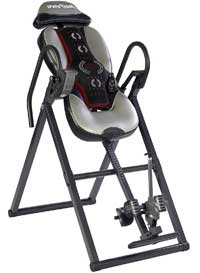Inversion therapy is a popular method for relieving back pain and reducing stress on the spine. Essentially, you hang upside down or at an inverted angle, which can decompress spinal discs and alleviate back tension.
However, hanging inverted comes with some risks and may not be suitable for everyone. Therefore, we want to evaluate alternative methods for relieving back pain to see which will work best.
Alternative Methods for Relieving Back Pain:
The good news is that if you’re looking for a natural alternative to inversion tables, you have options! Here are a few to consider:
| Inversion Table Alternatives | Benefits |
|---|---|
| Yoga | Offers a gentle and effective way to relieve back pain and improve flexibility at the same time. Many yoga poses, like downward dog and child’s pose, can stretch and strengthen the muscles in the back. |
| Massage | Works to relieve tension in the back and improve blood flow. Regular massage sessions can alleviate back pain. |
| Chiropractic Care | Chiropractor can manipulate the spine to reduce pain and improve mobility. This method can treat back pain caused by spinal misalignments. |
| Physical Therapy | Involves working with a licensed therapist to improve strength and mobility. If your back pain is caused by muscle imbalances or poor posture, this may a good option to try. |
What are the Pros & Cons of Inversion Tables?
The Pros:
First of all, inversion tables can decompress spinal discs and relieve pressure on the spine. As a result, they may be able to alleviate back pain and reduce the risk of injury. In addition, hanging upside down has shown to improve blood flow, reduce stress and improve flexibility.
Second, inversion tables can adjust to different angles, allowing users to customize their inversion experience. Some models also include extra features like massage and heat therapy, which can further enhance the benefits of inversion.
The Cons:
On the other hand, inversion tables do carry some risks. For example, hanging upside down can put strain on the neck, shoulders and back, which can lead to muscle strains, headaches and even nerve damage. Alternatively, you can try a back stretcher, which provides decompression, but doesn’t involve inversion.
Note: In addition, not everyone can do inversion therapy. For instance, people who have high blood pressure, heart disease or glaucoma should avoid inversion therapy or consult with their doctor. Pregnant women should also avoid inversion therapy.
Mistakes to Avoid When Using an Inversion Table:
1. Over-Inverting: Hanging upside down for too long can put strain on the neck and back. Thus, it may increase the risk of injury. So, start with short inversion sessions and gradually increase your inversion time. Another option is to try the Teeter Decompression Machine.
2. Not Using Proper Form: When using an inversion table, use proper form to avoid injury. Make sure to follow the instructions that come with the table and avoid fast twisting or jerking movements.
3. Skipping Warm-Up Exercises: Warm up prior to using your stretching out your spine. Take a few minutes to stretch and do light exercises to prepare your body for inversion therapy.
4. Ignoring Pain: Although inversion therapy usually feels slightly uncomfortable due to its awkward position, make sure to listen to your body and stop if you experience pain. Ignoring pain can lead to injury or aggravate existing conditions.
In short, inversion tables can offer a natural and effective method for relieving back pain. However, they also come with risks and may not be a good solution for everyone. Depending on your situation and health condition, you may want to try out one of the inversion table alternatives above instead.


